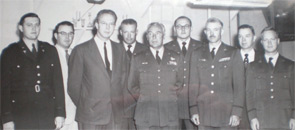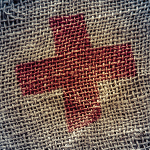In 1940, with clouds of war looming on the horizon, President Roosevelt created the Armed Forces Epidemiological Board (AFEB), a unique ”think tank” designed to anticipate the medical problems that the military would encounter during a war involving Europe, Asia, Africa, and the South Pacific. The members of the AFEB were some of the most outstanding academicians in the United States, weighted toward experts in infectious disease, and they served without remuneration or public acclaim, and their efforts remained largely anonymous. They organized and funded research programs to control the contagious and epidemic illnesses which historically followed armies in the field and they were responsible for minimizing many of these scourges. Over the next two decades, the AFEB was a major medical research effort by the federal government and this group served as the matrix for the subsequent development of the National Institutes of Health (NIH).
In 1948, the Streptococcal Disease Commission, a division of the AFEB, funded a research unit through Western Reserve University: the Streptococcal Disease Laboratory, under the direction of Charles Rammelkamp, Jr., MD. This organization was a function of the Department of Defense with the explicit mandate to rapidly find effective methods to treat, prevent, and control the group A streptococcal infections and their sequelae, acute rheumatic fever (ARF) and acute glomerulonephritis (AGN).
During World War II, group A streptococcal infections became the bane of the military bases. Thousands of young men were brought together at training bases and became a marvelous bacterial incubator. Epidemics of strep throat literally closed down training at bases such as Great Lakes Naval Base. It was estimated that during the war, respiratory disease was responsible for keeping the equivalent of two military divisions out of combat. And the costs in money and future health problems of thousands of individuals who suffered ARF are incalculable. At one time, a naval training base in Idaho was converted into a gigantic rheumatic fever hospital. With the impending Cold War, this medical disaster could not be repeated.
In order to staff the Streptococcal Disease Laboratory, the Department of Defense selected a group of young physicians from the selective service pool for immediate military service. These physicians were specifically chosen because of their research interests and ability and were plucked out of their residencies or research fellowships. I joined the staff at age 23—barely two years out of medical school, the youngest of the group—and remained at the Strep Lab for over two years while participating in all of the ongoing studies. During the seven years that the laboratory functioned, an additional 14 physicians sequentially participated in the clinical, epidemiologic, and laboratory research activities and published more than 60 original research papers on their activities while fulfilling their 24-month military obligation to the government.

Groundbreaking Research on Streptococcus
The Strep Lab was set up at a large military training base known to have had yearly epidemics of streptococcal sore throat, which provided the “population-at-risk” necessary to conduct the studies. The initial survey was to determine the natural history of untreated streptococcal sore throat, because this information was sadly lacking. In brief, it was found that, left untreated, the acute febrile illness would last one week and subside with minimal residua other than infrequent, treatable, suppurative complications. After an asymptomatic period of 14 to 28 days, about 3% to 5% of the patients would develop clinical ARF.
With this information, treatment studies were set up utilizing careful statistical methods to determine how many individuals would need to be put at risk in order to determine if therapy was effective in preventing ARF. Two groups of patients were used, a treatment group and an untreated control. The treatment group received penicillin for ten days and the control group was only given symptomatic therapy. With 1,000 patients in each group, the statistical difference was unquestionable, with 32 cases of ARF in the control group and none in the treatment group. This remained the main control study to be done by the staff. Studies utilizing other antibiotics were done with essentially the same result. Surprisingly, the use of sulfonamides proved to be ineffective in preventing ARF.
While the seminal studies were the successful therapy of acute strep sore throat, many other studies were done during the seven-year period:
- More than 1,200 patients with ARF were observed and treated with extensive information on the natural history of the disease.
- Treatment studies showed that corticosteroids were more effective than acetylsalicylic acid in preventing heart valvular damage.
- Studies of epidemics at Red Lake Indian Reservation and Bainbridge Navy showed that AGN was related to certain types of strep (types 12 and 4), a fact previously unknown. This was a serendipitous discovery that served to elucidate the previous dilemma, which confronted us in the epidemiologic differences in the occurrence of ARF and AGN.
During the seven years that the Streptococcal Disease Laboratory functioned, data were accumulated on the streptococcus, strep sore throat, ARF, and AGN, much of which remained unreported because of time restraints on the staff. The comprehensive studies by the medical staff on this organism and its diseases left few areas to be studied. The information was such that the staff was given the Lasker Award for Group Medical Research in 1954.
One of the frequent visitors to the Strep Lab was T. Duckett Jones, MD. Dr. Jones had spent his career as medical director of the House of the Good Samaritan in Boston, a hospital for patients with ARF. He was acknowledged to be the world authority on clinical rheumatic fever and was best known for having developed the Jones Criteria for the diagnosis of ARF, which have been universally used as the basis for making the diagnosis. Over his years of observation while at the Good Sam, he accumulated data on ARF, which are invaluable to all of us.
I had the opportunity to spend a day with Dr. Jones a few months before his untimely death. It was a marvelous learning experience. The problem that he confronted in the 1940s was a total lack of uniformity in how to diagnose ARF in clinical and epidemiologic studies. To obviate this deficiency, he proposed the Jones Criteria, which have since been universally accepted, with minor modifications. The five major criteria were used to restrict the number of patients to those who were unequivocal cases of ARF. In fact, two of the major criteria, erythema marginatum and Sydenham’s chorea, were each pathognomonic of ARF without any other evidence being considered. So, to demand the presence of two major criteria to make the diagnosis in a study group was to assure uniformity. However, the criteria were not designed for use by the practicing physician, but for strict research purposes only.
An Unmatched Experience for a Young Rheumatologist
The Streptococcal Disease Laboratory was a unique research experience. It was basically a medical military operation devised by the Department of Defense for one purpose: to eliminate the streptococcus as a significant health problem in the military. Once this was done, the lab ceased to have a purpose and it was ultimately disbanded. It is to the credit of the energetic young physicians on the staff that they utilized their time and the facility to the maximum and were able to study the group A streptococcus in more complete detail than anyone demanded. The information obtained was impressive and was largely responsible for the group’s receipt of the Lasker Award. Each member of the Strep Lab staff went on to impressive academic careers: professorships, deanships, and even one director of the NIH. What a group!
Dr. Morris’ medical career spanned seven decades. He was a founding fellow of the ARA (predecessor to the ACR) and served as faculty at several medical schools, but his true love was providing the best care he could for his patients. He spent the last quarter century of his medical career in private practice in Kingsport, Tenn.
Note: My father, Dr. Alton Morris, passed away this July after a lifetime of work in rheumatology. As a founding fellow of the American Rheumatology Association (ARA), my dad said he remembered a time when the organization was so small you could hold the meeting in the lobby of the New Orleans Fairmont Hotel. He was always modest about his experiences with the Strep Lab and his collaborators; while the work they did provided great insight into a major epidemiologic problem, they were content with the knowledge that they had made a difference in the lives of thousands, if not millions, of patients.
Dad recalled an incident in the early ’60s, in which Columbia University professor Charles Ragan was asked, “what does it take to be a good rheumatologist?” by a young fellow. After trying to answer the question, he finally stopped, looked at the fellow and said, “Do you know what it takes? About 20 years!” Dad epitomized Dr. Ragan’s observation. He never forgot that a thorough history and physical exam were the most important components of deriving the appropriate diagnosis, a fact he learned while working with some of the people responsible for our specialty. He would marvel any time he saw a new clinical finding not picked up in a patient. While he enjoyed his time in academia, it was his work with patients that kept him young. Even through his battles the last year of his life, he held hope that he would return to the practice he loved. He was a role model for all physicians fortunate enough to work with him, and he is sorely missed by his patients colleagues, and family.
Christopher R. Morris, MD
Arthritis Associates, Kingsport, Tenn.

